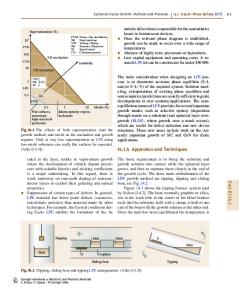Crystal Growth
- PDF / 4,119,034 Bytes
- 6 Pages / 604.8 x 806.4 pts Page_size
- 68 Downloads / 317 Views
Crystal Growth
A.L. Gentile and D.F. Elwell, Guest Editors Crystal growth is a vital and fundamental part of materials science and engineering, since crystals of suitable size and perfection are required for fundamental data acquisition and for practical devices such as integrated circuits. The word "crystal" comes from the Greek and means "congealed by cold." The term was originally applied to ice crystals and to crystalline quartz found in such locations as the Alps and thought, at one time, to be some permanently frozen form of water. As a crystallization process, crystal growth extends throughout recorded history— the crystallization of salt from sea water may have preceded pottery-making as the oldest method for controlled phase transformation of materials. The crystallization of salts such as sodium carbonate was known to the Egyptians, and the process of purification by recrystallization from aqueous Solution was described by Greek and Roman writers before the Christian era. The "father" of crystal growth, however, is generally considered to be the English scientist, Robert Boyle, who in 1672 described experiments relating the form of crystals to impurities and changes in growth rate. Boyle believed in the healing powers of crystals, part of the mysticism which has had a strong revival in recent times. We understand that crystals are particularly valued for enhancing the ability of the third eye to perceive auras, but are unable to offer warranted samples. Recognition as the "founder" of the theory of crystal growth is normally given to the American J. Willard Gibbs, who in 1878 published a seminal work on phase transformations, including a theory of the energy to generate a crystal nucleus and of the equilibrium form of crystals. In more recent times, crystal growth became organized as an independent discipline. In 1966, the first in a series of
MRS BULLETIN/OCTOBER1988
23
Crystal Growth
Andrew S. Jordan
Francesca Licci
Anthony L. Gentile, Guest Editor for this issue of the MRS BULLETIN, is a senior scientist and program manager of the Photonic Materials Program, Chemical Physics Department, Hughes Research Laboratories, Malibu, California. He received his PhD from Ohio State University in thermochemical mineralogy, specializing in high temperature phase equilibrium studies. Gentile has worked in several materials science fields, with emphasis on crystal growth, including solid-state laser crystals, IRtransmitting electro-optic and nonlinear crystals involving II-VI Compounds, and also ternary chalcogenide and pnictide Compounds based on the diamondlike semiconductor structure, IR fibers, and IR detector materials. He is currently involved in crystal growth of
TiC by a high-pressure float zone technique and deposition of ferroelectric thin films by atomic layer epitaxy Gentile is a member of the Materials Research Society, Sigma Xi (RESA), and the American Association for Crystal Growth (AACG). He served AACG as treasurer (1981-1984) and as president (1984-1987).
24
Dennis F. Elwell, Guest Editor
Data Loading...










